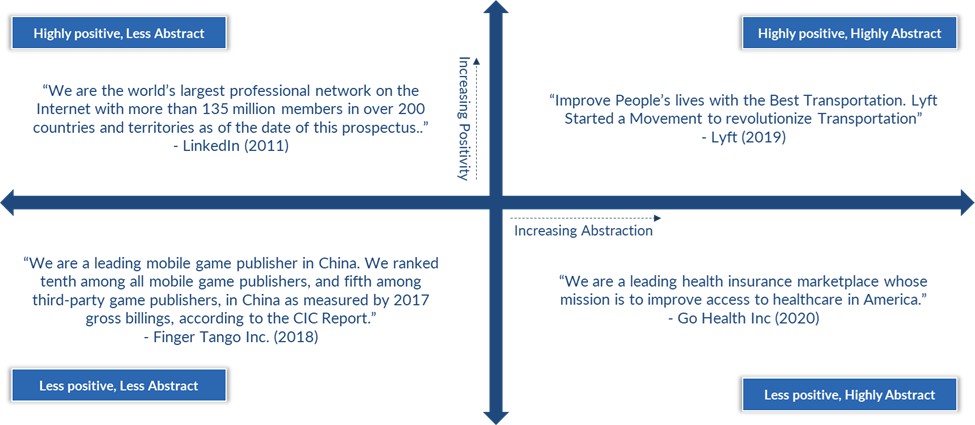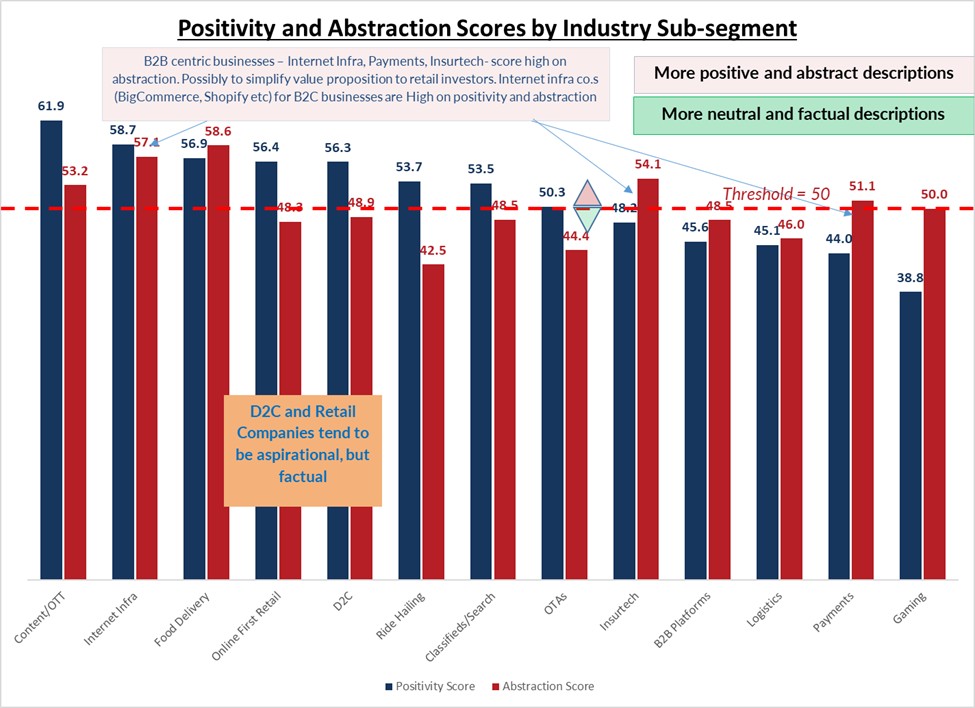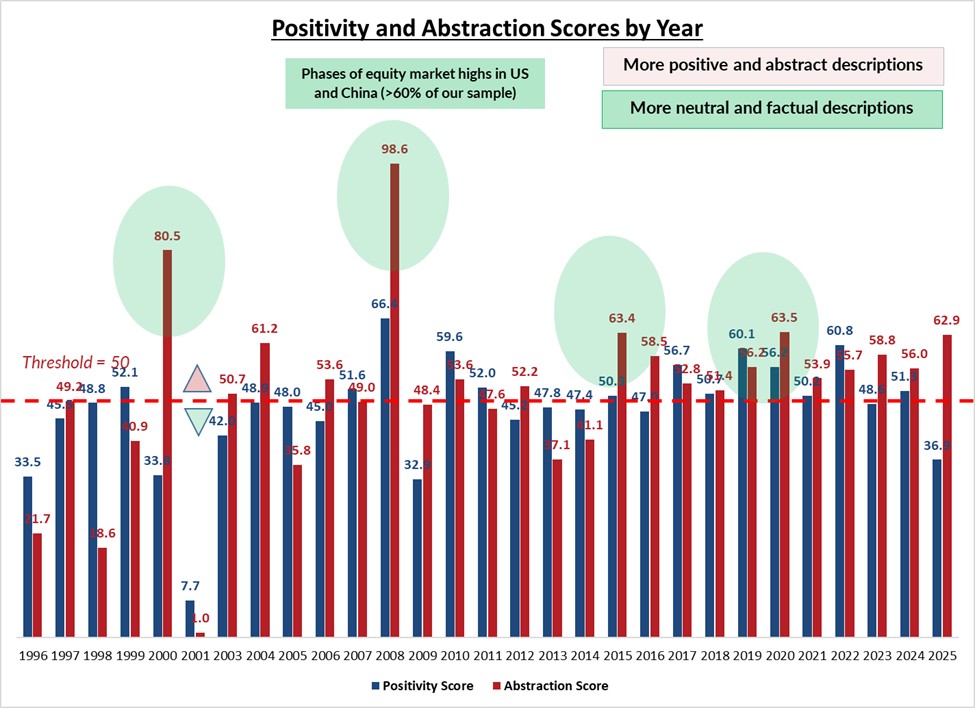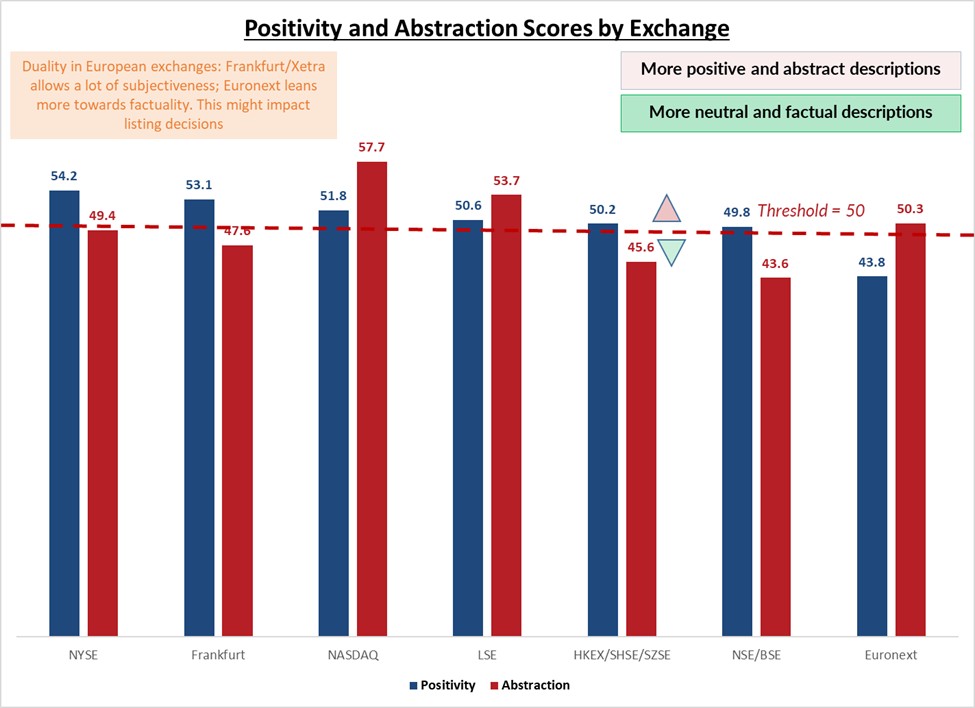“Coder|Innovator|Fitness Freak|Dad”
“Experienced professional with 20+ years in forensic financial analysis”
“Bain|Google|IIM-Ahmedabad|BITS Pilani”
How do you visualize these individuals after having read their LinkedIn introductions? Aspirational? Credentialed? Factual?
Each of these is a kind of positioning, meant to speak to a distinct kind of reader. Linguistically tailored for a specific moment in time. And circumscribed by the limits of an optimal mix of facts and aspirations that the platform – LinkedIn in this case- would allow.
Companies, from a legal perspective, are also living entities. And much like individuals branding themselves on a discovery platform, companies make significant efforts to find the right words and phrases to position themselves before their stakeholders. There is a better understood aspect of this exercise – the selection of brand taglines for marketing and corporate communications. In this context, the ultimate stakeholders are the current and potential customers.
The brand tagline for investors
However, there is another aspect of this communication that is understudied – that of how companies craft the introductory business statements in their IPOs. These statements can be thought of as a more permanent form of brand tagline – with their focus being on conveying a vision and positioning to their potential investors, instead of their customers.
Let me illustrate with an example why companies’ investor relations executives obsess about these opening statements for the business section in their IPO filings to the exchanges. Think of the Preamble to the Indian Constitution.
The Preamble to the Indian Constitution is a statement that defines and guides Indian polity. In a document that runs into 146 thousand words, this paragraph is the one that tells the reader what India is, as a nation. In a way, all the analysis of the country’s constitution must remain consistent with the vision of India laid out in these first few lines.
Similarly, we believe that companies considering public listing lay out their self-image in the first few lines of their prospectuses’ Business Overview sections. They tell us about industry-wide norms and the management’s vision for itself. They also end up becoming, like preambles, a touchstone to analyze managements’ actions.
What have we done? Why do we think this analysis is important?
Three months ago, we began a trivial exercise. Trying to advise a client on how to position their company for an IPO, we – like many others would have done in our place – sought inspiration from Google. We looked at what the tech behemoth had said in its IPO prospectus when it filed with the SEC to go public in 2004. The aspiration – mentioned in the first line itself – was to help “improving the ways people connect with information”. A mission statement that all its subsequent products and initiatives have largely stood by.
We then stepped down that rabbit hole and subjected over 300 tech IPOs in the past 30 years (offerings > USD 20 mn) to a more serious analysis. We considered 13 technology verticals - Logistics-Tech, Online-first retail, Internet Infrastructure, Content/OTT, Food Delivery, D2C, Ride Hailing, Classifieds/Search, OTAs, Insurtech, B2B Platforms, Payments, Gaming

Chart 1: Illustrative examples of statements based on our sentiment analysis algorithms
We ran the business overview sections of these IPOs through a Natural Language Processing (NLP) algorithm to test the introductory statements for two aspects:
- Positivity: Presence of superlatives, strong adjectives and other Mission/Vision statement related words/phrases
- Abstraction: The extent to which descriptions rely more on subjective/explanatory statements that cannot be backed by data
Our NLP algorithm assigns two scores, ranging from 1 to 100, to companies on each aspect – Positivity and Abstraction. Companies with a score > 50 on Positivity tend to be more superlative in their statements (and vice versa) than normal. Those with a score > 50 on Abstraction in their introductory statements, tend to be more abstract than normal (and hence less factual). It is important to say here that all companies in our sample make exchange-appropriate disclosures on KPIs and Financial Metrics. What we are measuring is how much of the factuality and neutrality in communication is shown in the metaphorical “preamble” – the opening paragraphs of the business overview section.
Chart 1 gives some illustrative archetypes of companies in each category.
The differences in Lyft, which went public in 2019, and identified itself as being at the vanguard of a transportation revolution, and Visa, which debuted in 2007, as an industry leader in payment processing, are stark.
We believe that this analysis will be relevant to any executives or institutional investors involved in drafting IPO documents with regulators. Mainly so because it is the first attempt, in our knowledge, to create a comparable and calibrated measure of the tone and factuality in what tech companies going for an IPO like to convey to their investors.
And particularly because it specifically tries to answer these three questions:
- Change in the tone of Business Overview Statements of IPOs over time, and with business cycles
- Are companies in some industries more likely to define themselves in an abstract manner, compared to others?
- Are some exchanges more/less lenient with opening statements in the Business Overview section?
If your branding and scale is your moat, be more superlative and abstract

Chart 2: High Dependence on Brand Value and Scale: High Poetic (Positive & Abstract)
The chart above shows each of the 13 subsegments of tech that we consider scores on positivity and abstraction.
Four things stand out for us here
First, we note how highly positive and abstract the companies in online content (Netflix, Youku) and Food Delivery (Doordash, Deliveroo, Zomato) tend to be in their opening statements, relative to other tech peers. We suspect that in a highly asset light business – such as the content streaming platforms operate- branding plays a bigger role in underpinning why they will continue to outperform their peers and attract creators, than bare operating metrics. Similarly, the highly poetic nature in which food delivery companies introduced themselves might be a deliberate strategic move to frame a public offering as transformative, when they were dependent on a further expansion in scale for profitability.
Second, at the right end of the chart lie companies in the Logistics-tech, Gaming and Payments space, which have traditionally been more restrained in their business descriptions – preferring to quote market shares and financial performance. One reason that might have been so is that companies in this space tend to IPO later in their lifetime, having already achieved a measure of cash flow positivity before hitting the markets. Second, this communication could be a deliberate strategy to communicate to a different kind of investor – an old-school accumulator who looks at a linear, cash flow yielding growth curve instead of an explosive, hockey-stick one.
Third, given that IPOs are essentially public offerings, B2B tech companies – in Internet Infra, Insurtech and sometimes even Payments – tend to be more abstract in their opening statements. The motivation could be to simplify an extremely technical, and barely experienced value proposition for retail investors. For instance, BigCommerce went public in 2020 by with these opening lines
“BigCommerce is leading a new era of ecommerce. Our software-as-a-service (“SaaS”) platform simplifies the creation of beautiful, engaging online stores by delivering a unique combination of ease-of-use, enterprise functionality, and flexibility.” Aspirational. But Digestible.
Fourth, D2C and Online-first retail platforms behave in just the opposite way. While they tend to be more superlative (Positive) in their opening statements than Internet Infrastructure companies, they tend to be less abstract. We believe that this once again comes down to the nature of their business – several potential retail investors in the IPO might already be their customers. As a result, they like to present themselves as aspirational in their mission, but at the same time highly empathic on their market share, retail presence and other operating metrics – number of SKUs/Product lines. The latter because they know that retail investors might already be familiar with these terms and might even be calibrating them mentally before applying for an IPO.
There is a cyclicality in the Positivity and Abstraction in IPO Language.
The chart below arranges the same companies by positivity and abstraction, but now by year of going public.

Chart 3: Equity market highs see high positivity and abstraction in IPO Languages
Source: Company filings
The first thing to notice here is how both the scores – blue and grey bars, have trended up since 2020. There seems to be a significant and measurable increase in the degree of abstraction and positivity in IPO language for tech companies since 2020. That might underscore the increased retail investor participation in IPOs globally, debuts by tech companies in public markets without having gained operating/cash flow profitability and the leniency among exchanges to allow high growth internet companies to tap public markets with easier financial performance requirements.
The second, and we are extremely cautious with our conjecture here but couldn’t help noting it, is how neatly the jump in Abstraction (and sometimes Positivity) scores aligns with an impending IPO bubble. Abstraction and Positivity score jumped in 2000 (the Dotcom Bubble), 2008 (run-up to the GFC), 2015 (Chinese retail bubble) and 2017,2019 and 2020 (the debut years of the first cohort of Internet 2.0 companies like Uber, Lyft, DoorDash and SPACs).
We suspect that a change in language happens at these critical moments simply because companies tend to capitalize on the FOMO in the public markets. However, not all of those looking for debuts may have the credentials to validate the valuations they seek. That sets off a frenzy of highly poetic, non-verifiable language, specifically in the opening statements of the business section – which the retail investors/financial media is most likely to read. Given that corporate insiders tend to know more of the market than retail investors, the tonality of language, taken in aggregate, could be a good additional red flag for regulators and exchanges to look for, when they are evaluating the Draft Prospectuses of tech companies looking to go public.
Where Are the Lenient Exchanges?
As another exercise, we look at Positivity and Abstraction scores, now organized by exchanges. The chart below helps us understand the leniency bias among them, which might also influence the listing decisions by tech companies.

Chart 4: Emerging Market exchanges require more neutral and factual statements
Source: Company Filings
We find that in general, emerging market exchanges allow more neutral and factual statements than those in developed markets. There is an important catch here though. Not all emerging market tech companies list on emerging market exchanges. The exchanges in the developing world which can absorb IPO offerings > USD 20 mn in the tech space, in our sample were mostly in India and China (we consider UAE and Saudi Arabia as developed markets for our analysis).
What stands out here is how notably restrained, compared to NYSE, NASDAQ and LSE, are the IPOs on NSE/BSE – something that runs contrary to public opinion. We believe that despite retail investors still not having made money on their subscriptions to IPOs like PayTM, Delhivery, Nykaa and Ixigo, there is little to ascribe the blame to the promises made by the companies in their prospectuses.
As an aside and interesting note, it is also worth looking at the duality in leniency in European exchanges. Frankfurt/Xetra – the big German exchanges allow a lot of latitude in language while listing. On the other hand, Euronext seems to be home to IPOs that are notably restrained in their introductions. That might impact listing decisions for European tech companies. Or, as a corollary, it might attract the lemons of the collection to the Frankfurt stock exchange. That last bit is not speculation. Wirecard, the erstwhile poster-child and now-Enron of German tech space, was one of the stars of Frankfurt stock exchange until the 2020s, and one of the many companies on the exchange which, through the 2000s, had been involved in serious corporate governance scandals.
The role of narrative in IPO framing
This exercise began as a trivial pursuit. However, the results we have seen are in no way incidental. If I were to condense this exercise into a few takeaways, they would be these.
How companies introduce themselves to their investors is a strategic framing decision that varies depending on the type of business, the awareness of retail investors about the business and the timing of the IPO. Analysts, financial journalists and the discerning public also must evaluate these comments, especially the opening ones, with this lens.
There is something about the boundaries that stock exchanges set, that defines how companies tell their stories. The regulators need to be aware of their own biases and thereafter dial up/down the level of latitude required in opening statements of the business overview section, to decide what kind of companies they want to list, keeping in mind the maturity level of investors.
Finally, what and how you introduce yourself to your investors also depends on what kind of company you are. We hope that this study adds to their intuition as well.
